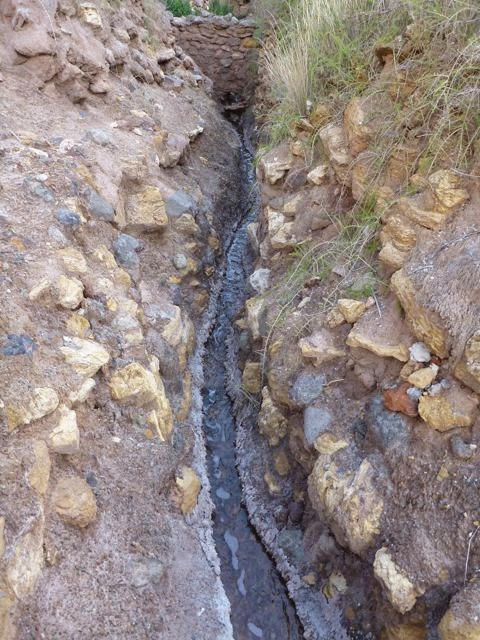Speaking of Machupiccu, it is maintained with the help of llamas which may be found wondering among the ruins and cropping the grass. They provide a very pleasant contrast to the lifeless stones around them and provide great amusement to the throngs of tourists taking photos.
After joining a tour of the central area, Deb and I venture out along a trail that was a key access route before the coming of the roads, the busses and the trains. In places, this trail is only a narrow shelf cut in a sheer rock wall with a drop that must exceed a thousand feet. There is a unique feature in this trail, consisting of a missing section of the "shelf" spanned by a couple of logs that are easily removable. Of course this makes the main village easier to defend from hostile forces like Spanish Conquistadores.
 |
| We don't cross the "Inka Bridge." This is far enough. |
To be clear, we understand the Spanish never visited Machupiccu and there is no evidence of battle.
Back in the central area, we swing through again, trying to absorb the significance of the structures.
 |
| Mysteriously shaped stones are the centerpieces of several courtyards may have been altars. |
Stone steps and water-courses are abundant and we enjoy thinking about the feet that trod the steps before us. As the bard once wrote. "So light a step will n'er wear out the everlasting flint."
 |
| Approaching the altar. |
There are just a few restored buildings which give a sense of the appearance in the fifteenth century and in the case of two buildings, shelter scantily clad tourists from a brief rain shower.
 |
| Guard House or Storage - Memory fails |
The entire complex is served by streams that originate higher on the mountain and follow channels through various buildings and sixteen fountains. There is a separate drainage system for rainwater runoff which includes a porous sub-base in each of the terraces to prevent them from becoming mud slides decorated with corn and potato crops rushing down the mountain.
 |
| Did I mention the water still follows the channels? |
Dear reader: amateur bloggers tend to get the sequence of blog posts inverted from time to time and on behalf of amateurs everywhere, I beg your indulgence.











































